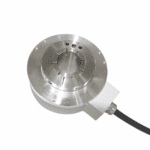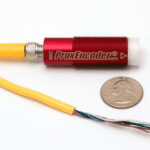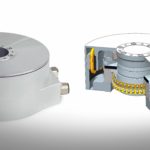We asked encoder manufacturers to weigh in on the trends they’re seeing in their industries. Here’s what they had to say.
What new design trends are you seeing in areas such as robotics, battery powered designs, automated vehicles, and safety in motion control designs?
Jonathan Dougherty
Product Specialist
HEIDENHAIN
HEIDENHAIN rotary encoders are critical components found in Automated Guided Vehicles (AGVs) used in distribution warehouses, manufacturing plants, and medical facilities globally.
These encoders typically provide motion and speed feedback in motors operating a multitude of the axes found in these applications, with the most common axis being the motors used on the drive wheels of these AGVs.
Our encoders also offer a slim, lightweight design allowing designers more flexibility, especially in applications where space and weight are critical. The encoders combine brushless motor commutation pulses and incremental position feedback, which reduces the cost while improving the performance and reliability of the brushless motor/encoder package.
Robots
One key driver in robotics has been the aerospace industry because it must perform highly accurate machining operations on large components. A robot, however, can easily reach any position on a large component, such as the fuselage of an aircraft, and can perform tasks on it such as drilling and milling. However, accuracy is impaired by many factors for these kinds of applications and the tool center point (i.e., the tool at the end of the robot’s arm) must be positioned and guided with sufficient accuracy. This is where the classic industrial robot runs up against its limits.
Yet robot manufacturers have been responding to this problem with highly dynamic motor control, use of secondary encoders for highly accurate position measurement, and implementing accurate position measurement for movable robots.
In this industry, classic rotary encoders continue to provide the servo motor feedback at the robot’s axes. Because servomotors require high control dynamics, encoders that deliver high control quality and system accuracy that are resistant to strong vibrations are ideal. HEIDENHAIN provides a line of inductive rotary encoders, which support these features along with offering safety levels up to SIL 3, or category 4 PL e.
Additionally, robotics manufacturers have found they can significantly improve the absolute position accuracy of their robots by using additional, high accuracy angle encoders or rotary encoders at every robot axis. These so-called secondary encoders, which are mounted after each gear train, capture the actual position of every robot joint. This allows the encoders to account for zero position error and backlash, which results in a 70 to 80 percent improvement of the absolute position accuracy at the tool center point.

For the highly accurate positioning of robots with a linear drive, enclosed linear encoders from HEIDENHAIN are used in lengths of up to 30 m. Position measurement from a linear encoder compensates for thermal errors and other factors that influence the feed mechanisms. These factors cannot be captured by means of conventional position detection methods based on the pitch of the recirculating ball screw and the angular position of the rotary encoder on the motor.
Safety and (motion) control on common networks
Functional safety is playing an increasingly important role in machine-tool manufacturing and now the automation world. In fact, countries in the European Union already require it in many applications, and regulations are being considered in the United States and Asia as well. For encoders, that doesn’t only mean correctly and accurately measuring position data and transferring it to the machine control. Functional safety also includes encoder diagnostics and mechanical fault exclusion.
For a machine designer, the Functional Safety certification process can be arduous and confusing; assessing an entire system component by component to ensure redundancy and mechanical fault exclusion is inefficient and costly. HEIDENHAIN offers a range of pre-approved, safety-related position measuring systems which can achieve safety levels up to SIL 3, PL e, category 4, to remove some of the burden on the machine designer.
Jeff Smoot
VP of Application Engineering & Motion Control
CUI
CUI has been actively involved in many of the emerging markets and recent innovations in motion design. Our products are inherent and integral components of the motion control system and are helping to drive innovation in automation.
In the motion industry we are committed to the growth and development of the next generation of motion engineers. CUI is a proud supporter of the FIRST Robotics program on all levels; from contributing our AMT10 encoders to the FIRST Kit of Parts, financially supporting local teams and volunteering as First Lego League coaches and mentors. It is our belief and hope that the FIRST program will inspire and help cultivate the next generation of motion engineers that will drive innovation for years to come.
Christian Fell,
VP, Technology and Custom Solutions
POSITAL-FRABA Inc.
Robotics
We’re excited about the emergence of collaborative robots or “Cobots”. These are smaller and less powerful than traditional industrial robots and designed to operate beside people in a shared work environment. To operate safely, they need sophisticated sensor systems that include encoders for position control, along with presence sensors and force transducers to help avoid collisions with people or equipment. These sensors need to be compact and adaptable, accurate and cost effective. POSITAL encoders have already made an appearance in this market and we expect that our kit encoders and capacitive encoders are well positioned to fit into Cobot designs. Our kit encoders are, in effect, the sensing elements of our popular magnetic encoders sold as separate modules that can be easily built into servomotors, stepper motors or other rotating mechanisms to provide position feedback and commutation signals. Capacitive encoders, currently under development, will be available in through-shaft (ring-shaped) configurations that can be readily incorporated into robot arm joints or other applications where the sensor must fit around a central shaft.
Safety and motion control on common networks
We have recently introduced a line of rotary encoders with redundant, diverse, sensing elements. These devices have two separate rotary sensors mounted on a common shaft, in a shared housing. One is an optical sensor that measures rotation angle with a code disk and array of photocells, while the other is based on our magnetic rotation measurement technology, featuring Hall-effect sensors and signal processing software. These independent measuring mechanisms allow machine builders or system integrators to improve the functional safety and reliability of their systems by reducing the possibility of undetected sensor malfunction. Readings from the two rotation sensors can be compared by the control system to ascertain the everything is working correctly, or to signal that a safety shut-down is needed.
How do you see IIoT influencing your products and what you supply to industry? In what ways is your company helping end users increase use of application data?
Jonathan Dougherty
Product Specialist
HEIDENHAIN
One of the biggest benefits of modern encoders is their ability to act as multimodal sensors. Increasingly, encoders are being fitted with additional sensors such as temperature transducers, voltage meters, and humidistats. These sensors allow for greater condition monitoring of the encoder along with overall machine.

Our first step was through adding an additional external temperature sensor, which could be used to monitor the temperature of the motor windings to avoid overheating.
One big step forward was through our Leine and Linde brand encoders where we introduced the Advanced Diagnostic System (ADS) Online. The ADS Online system monitors a number of parameters and characteristics in the encoder that are fundamental to its functioning. The operator can set alarm levels on any of these parameters, as well as set logging intervals for trend evaluation with the ADS software and, by monitoring trends in performance, it is possible to predict end-of-life conditions and plan maintenance activities before a failure occurs. The addition of online access to the current capabilities also brings enhanced functionality like vibration and temperature monitoring. With ADS Online, the encoder may be connected to an Ethernet network to provide access to diagnostics and analysis regardless of location.
Jeff Smoot
VP of Application Engineering & Motion Control
CUI
The Industrial Internet of Things (IIoT) and the ability to harness sensor data, machine-to-machine (M2M) communication and automation technologies are revolutionizing the way machines capture and communicate data. These advances are driving what have historically been analog devices to evolve and join the transition or become obsolete. CUI’s line of digital ASIC-based AMT encoders bridges this gap and incorporates valuable diagnostic and programming tools that can speed the time to market and reduce machine downtime in the field. The diagnostic data can be used to quickly determine if the encoder is operating properly, has failed or become misaligned. This data can be used to make smarter and more reliable systems as well as monitored over time to provide performance trends that can be analyzed and used to predict failures.
What are some newer products your company sells with features to impart simplicity or turnkey operation?
Jonathan Dougherty
Product Specialist
HEIDENHAIN
HEIDENHAIN has launched a new product family that is a merger of HEIDENHAIN bearing and angle encoder technologies. Resulting in the MRP 2000, 5000 and 8000, these unique modules contain bearing sets not conventionally available and are able to be integrated with various encoder types to yield highly stiff modules that are easy to install. The angle encoder modules represent a successful merging of the key requirements for precision rotary axes used in metrology, calibration devices, automation technology, micro machining, and the semiconductor industry.
Key features of the MRP series bearing include high guideway accuracy combined with high rigidity, a low starting torque and a constant continuous torque. At the same time, value was placed on compact dimensions due to the fact that the bearing raceway are machined directly onto the shaft. Bearing loads up to 300 N are possible while still maintaining the system accuracy.
Jeff Smoot
VP of Application Engineering & Motion Control
CUI
CUI’s AMT encoders were designed with simplicity and ease of installation and operation in mind. Features such as “One Touch” zeroing allows for simple, repeatable, and straightforward alignment of the encoder’s index signal and commutation outputs, dramatically reducing the time and headaches normally associated with this process during manufacturing. Furthermore, the programmability of the AMT encoders via our AMT Viewpoint GUI offers maximum flexibility to the designer allowing for optimization of the motion control system with a click of the mouse. Finally, the integrated diagnostics available within the AMT family allow for assessment of the motor and motion system to ease troubleshooting, both during the design and prototyping process as well as once the product is in the field.
Christian Fell
VP, Technology and Custom Solutions
POSITAL-FRABA Inc.
Our kit encoders for servomotors or stepper motors are available with single-cable connectivity, based on the open-source BiSS Line communication protocols. Single-cable connectivity combines power and data communications onto one cable with a single connector. This simplified approach to wiring makes position-controlled motors less expensive to manufacture and easier to install.
What kinds of customization have you done on your products to satisfy specific customer and application requirements? What design problems are you eliminating with this customization?
Jeff Smoot
VP of Application Engineering & Motion Control
CUI
CUI’s digitally based AMT capacitive encoders are suited for providing the customization required by more and more of today’s demanding applications. All standard AMT encoders are programmable with up to 20 different output resolutions, allowing the designer the upmost flexibility in their design, with the ability to change the encoder resolution with a few simple keystrokes using the AMT Viewpoint GUI. In addition to this standard programmability, the digital nature of the AMT encoders allow for additional customization in a greatly compressed timeframe when compared to a traditional encoder technology. In recent months, we have provided customized resolutions, sampling rates, and communication protocols to customers, allowing for greater optimization of their motion system and improved performance of their end product.
Christian Fell,
VP, Technology and Custom Solutions
POSITAL-FRABA Inc.
“Mass customization” is central to POSITAL’s business plan. Our position and motion sensors are designed to be highly modular, with largely interchangeable components and sub-assemblies. As a result, we can offer encoders and inclinometers with a range of performance specifications, communications interfaces and mechanical configurations – over a million choices in all. We are continually updating our catalogue to meet local and emerging requirements. Customers can order just what they need, whether for a new design or as a drop-in replacement for older equipment where the original encoders are no longer available, or where new capabilities are needed.
Describe a newer component offering that your team designed with miniaturization in mind.
Jonathan Dougherty
Product Specialist
HEIDENHAIN
HEIDENHAIN is actually working on a next generation of our Renco brand encoders with miniaturization in mind. The key advantage is its compact design combined with an easy, self-centering mounting method.
The new generation encoders will have increased functionality along with feedback signals to assist in the mounting process. We are also looking to eliminate cumbersome commutation alignment procedures with an easy programmable shift. This is all done in a package that will be only 8.7 mm in height, our lowest mounting profile yet.
How do you see battery-powered designs (for mobile equipment and consumer products) prompting design changes?
Jeff Smoot
VP of Application Engineering & Motion Control
CUI
With more and more applications relying on battery power, careful management of the limited power budget of the system is essential. Every milliampere-hour of battery energy becomes increasingly precious and the need for maximum efficiency extends to all aspects of the design. Within an electric-actuator this extends to the method for commutating the motor as well as for measuring the travel. Encoders, with dramatically lower current consumption than traditional magnetic solutions are coming to the forefront as part of the solution to reduce the overall power budget and maximize battery life. Among available encoder technologies, capacitive encoders are growing in favor for battery-powered designs thanks to a typical power draw much lower than traditional optical encoders.






Leave a Reply
You must be logged in to post a comment.